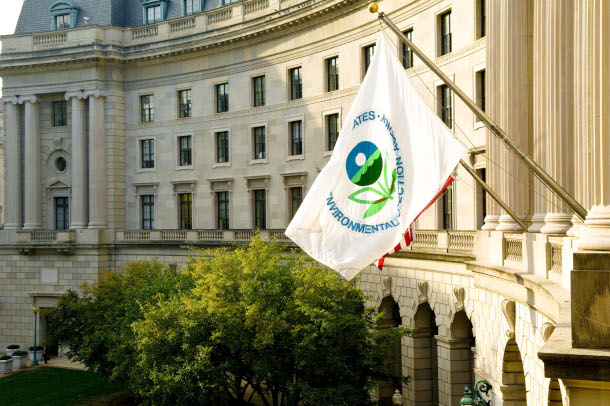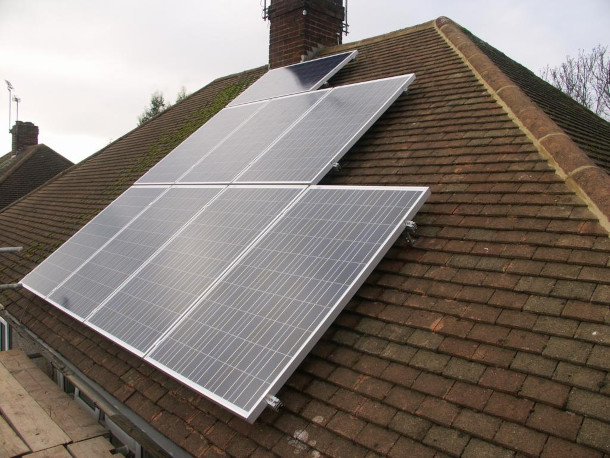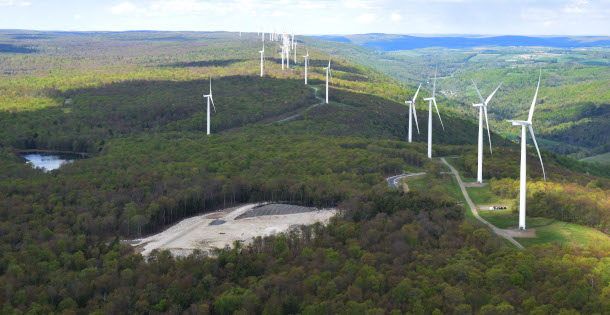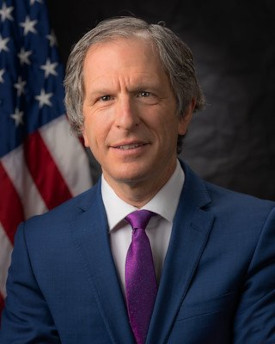Big Cash for Clean Energy
Air Date: Week of April 12, 2024

The Environmental Protection Agency has awarded grants -- ranging in the hundreds of millions to billions of dollars -- to eight nonprofits that will loan the money to clean energy projects. (Photo: US EPA, Flickr, Fair Use)
The Biden Administration EPA recently awarded $20 billion to organizations who will turn around and offer low-interest loans to help communities participate in the clean energy transition. EPA Administrator of New England David Cash and Host Steve Curwood cover how the program is catalyzing far more private capital and will help fund projects like insulating homes and replacing gas heating and cooking with heat pumps and induction stoves.
Transcript
CURWOOD: It’s Living on Earth, I’m Steve Curwood.
As part of the bid by the Biden administration to fight climate disruption, the Environmental Protection Agency recently awarded $20 billion to help finance clean energy projects across the United States. The money is part of the Greenhouse Gas Reduction Fund, created under the Inflation Reduction Act. Unlike a typical grant program, the EPA will not fund projects directly. Instead it is providing grants to select organizations who will turn around and offer low-interest loans in communities that need them the most. The $20 billion in federal funds are expected to stimulate as much as $150 billion more in private capital to advance the clean energy transition. Here to explain is David Cash, Administrator of EPA's New England Region. Administrator Cash, welcome back to Living on Earth!
CASH: It's great to be on the show, Steve.
CURWOOD: Tell me, what sort of work went into building this grant program?
CASH: Yeah, so the Greenhouse Gas Reduction Fund, this is just one of the many, many different efforts that the EPA and the Biden-Harris administration is making to address the climate crisis and to grow the clean energy economy here and to reduce energy costs for people all over the country. So this is just one piece of that. And it was created in President Biden's Inflation Reduction Act. And with the program, EPA is creating a first-of-its-kind national network of mission-driven, community-led, financial institutions. So you could think of these institutions that says, creating, you know, loan funds that can go out to communities that will finance climate, clean energy projects, and especially in low-income and disadvantaged communities.
CURWOOD: So I gather there are a couple of parts of this process. What are they?
CASH: Sure, so there are three big parts of the Greenhouse Gas Reduction Fund. The first I'm not going to talk about, it's the Solar for All program, $7 billion. We haven't made a final announcement on that, that's coming probably later in the spring. But the two big pieces that were announced are the National Clean Investment Fund, that's $14 billion, and the Clean Communities Investment Accelerator, that's another $6 billion, so $20 billion dollars. And the first one, the National Clean Investment Fund, it has three selected applicants, and those will create funds, partnering with the private sector to provide accessible, affordable financing for tens of thousands of clean energy projects nationwide. So enabling individuals, families, nonprofits, governments, businesses to access capital in a way that they haven't been able to before. We know that there has been underinvestment in this country in clean energy, clean technology, clean deployment. And that's what this is designed to do.

The Greenhouse Gas Reduction Fund (GGRF) was authorized by the Inflation Reduction Act (IRA) largely for clean energy and energy efficiency projects. Among the programs is Solar for All which will award up to 60 grants to expand the number of low-income and disadvantaged communities primed for residential solar investment. (Photo: Jonsowman, Flickr, CC BY 2.0)
CURWOOD: Give me a couple of examples of what this might finance.
CASH: Sure. So let's say, for example, there is like an affordable housing provider that's rehabilitating a 50-year-old, 200-unit, Section 8 rental property. We know these are all over the country, these kinds of affordable housing projects. And they may be short on financing to fully electrify the building, to get them up to a way where they'll be as energy efficient as possible. So the funds can then help finance that network. And the affordable housing provider can be able to turn to that network and fill the specific financing gaps for these kinds of projects. And let me bring this down to the really personal level. We visited a public housing unit in Boston where we met with some of the tenants who showed us the gap underneath their door that they said snow blew into, they showed us windows that didn't close completely, they showed us old appliances that were incredibly energy inefficient. This kind of funding is going to be able to rehab that apartment to make sure that that family is comfortable, pays less for their electric bill, has new appliances, and is part of the clean energy future. And we see these funds, these $20 billion, leveraging private funding in like a seven-to-one ratio, about $150 billion for a $20 billion investment roughly. It's going to be huge.
CURWOOD: And let's talk about the other part then.
CASH: Sure. So the Clean Communities Investment Accelerator, those are designed to establish hubs to provide funding and technical assistance to community lenders. And working primarily all of those, that $6 billion, is going to low-income and disadvantaged communities. By the way, a large section of that prior one I mentioned to you, the 14 billion, is also going to low-income and disadvantaged communities. Those communities, by the way, who have suffered under the burden of pollution in the last decades. And in fact, those communities that have been dependent on the fossil fuel economy, but have seen that waning. And so these are funds that can go out to those communities and create a new clean energy economy and jobs and investments there as well. And you know, one of the things about this is we've often heard from federal government that federal government can be top down. These programs are designed to be bottom up, to respond to the needs of communities so that communities are driving where investments go.

Appalachian Community Capital, a nonprofit CDFI working with community lenders in Appalachia, is slated to receive a $500 million award and plans to launch the Green Bank for Rural America. (Photo: Ted Auch, Flickr, FracTracker Alliance, CC BY-NC-ND 2.0)
CURWOOD: So how can these communities get access to these funds? Typically, more affluent communities have people who know how to write grant proposals and work the government system. If you're living in public housing where the snow is blowing under the door, it’s unlikely that you have kind of the intellectual capital to navigate the system. So how do you get folks who need it to get plugged into the system?
CASH: Yeah, so here's one of the things that was brilliant about the way that our team in headquarters structured the competition process for these. Each of the winners have had to articulate how they are going to connect precisely with the community lenders, such as community development, financial institutions, credit unions, minority depository institutions, how they're going to connect with those, so that when you have a household, or even a community organization, they're already going to be tapped into the network. So that communicating about the availability of these kinds of funding opportunities, these kind of revolving loan funds, will be made more and more apparent to those who precisely need it. You know, in fact, what I mentioned to you before about communities that have depended on fossil fuel economy, one of the hubs is going to be the Appalachian Community Capital, a nonprofit CDFI, which has a decade of experience working with community lenders and Appalachian communities, so they know who to go to. And similar on the tribal side, so tribal communities will know where to go.
CURWOOD: For folks who don't know, what's a CDFI?
CASH: Yes, so it's a community development financial institution. So you can think of it as a lending institution, a bank that is closely connected to communities that otherwise would have a difficult time raising capital. Unlike what you had said, you know, in your relatively wealthy community, there's going to be a lot of understanding about how to access this capital and these CDFIs go a long way toward creating that capacity in these communities.
CURWOOD: So if you were to summarize, what are the environmental issues that these grant programs are seeking to redress?

David Cash is the Administrator of EPA's New England Region. (Photo: Courtesy of the EPA)
CASH: Clearly the climate crisis. We know that we need to take action on that, and urgent action. So these investments are going to go a long way in reducing emissions that cause climate change by deploying solar and wind, electric vehicles, by doing energy efficiency, which in many cases is by far the cheapest way to reduce emissions. So that's one. The other is addressing local air pollution. Again, we know, whether it's through power plants, or manufacturing facilities, or buses, or trucks or cars, that local air pollution is a huge problem and a huge problem in communities that have been overburdened by these pollutants for decades upon decades. And then on the water side, we see the replacement, for example, of lead pipes as incredibly important for communities that have relied on the old housing stock. So we see a lot of that in New England, of course, where we have buildings that are, you know, 100-plus years old, we're gonna find a lot of lead pipe. And we know that lead is particularly damaging to children. And so President Biden has a goal to get rid of all lead pipes in the next 10 years. And there's billions of dollars that are in the bipartisan infrastructure law that's going to address that. And of course, it goes hand in glove with creating new clean energy jobs, whether it's to put on a solar panel on your roof or replace the windows or put in heat pumps, you know, those are all opportunities for huge job growth.
CURWOOD: So how excited are you about this $20 billion and this program that you and the folks at the EPA are now administering?
CASH: Yeah, so it's interesting, EPA had grant programs and got money out the door, but nothing, nothing on the scale of what we're doing now. And it's incredibly exciting, because we're at a moment where it's both incredibly urgent that we take action and we have huge opportunities. And so to be part of an agency that is going to be providing funding in the way that we're providing, lifting up communities, helping them identify what they need, where they want the investments to be, so that they can reduce their costs, so that they can breathe cleaner air, so that they can be part of the clean energy job growth. I mean, that's incredibly exciting. And for this project to be just part of one of many that EPA, the Department of Energy, Department of Commerce are working on to get these kinds of results. Very, very exciting, Steve. This is, you know, I wake up every morning and, you know, basically I skip to work.
CURWOOD: Well, I want to thank you, David, for taking this time with us today. David Cash is Administrator of the Environmental Protection Agency's New England region. Thanks so much.
CASH: It's been a pleasure, Steve, thank you so much, and it's an incredibly exciting time to be talking about this. Thanks.
Links
The Washington Post | “America’s New High-Risk, High-Reward $20 Billion Climate Push”
Learn more about David Cash the Administrator of EPA's New England Region
EPA | “Summary of Inflation Reduction Act Provisions Related to Renewable Energy”
Living on Earth wants to hear from you!
Living on Earth
62 Calef Highway, Suite 212
Lee, NH 03861
Telephone: 617-287-4121
E-mail: comments@loe.org
Newsletter [Click here]
Donate to Living on Earth!
Living on Earth is an independent media program and relies entirely on contributions from listeners and institutions supporting public service. Please donate now to preserve an independent environmental voice.
NewsletterLiving on Earth offers a weekly delivery of the show's rundown to your mailbox. Sign up for our newsletter today!
 Sailors For The Sea: Be the change you want to sea.
Sailors For The Sea: Be the change you want to sea.
 Creating positive outcomes for future generations.
Creating positive outcomes for future generations.
 Innovating to make the world a better, more sustainable place to live. Listen to the race to 9 billion
Innovating to make the world a better, more sustainable place to live. Listen to the race to 9 billion
 The Grantham Foundation for the Protection of the Environment: Committed to protecting and improving the health of the global environment.
The Grantham Foundation for the Protection of the Environment: Committed to protecting and improving the health of the global environment.
 Contribute to Living on Earth and receive, as our gift to you, an archival print of one of Mark Seth Lender's extraordinary wildlife photographs. Follow the link to see Mark's current collection of photographs.
Contribute to Living on Earth and receive, as our gift to you, an archival print of one of Mark Seth Lender's extraordinary wildlife photographs. Follow the link to see Mark's current collection of photographs.
 Buy a signed copy of Mark Seth Lender's book Smeagull the Seagull & support Living on Earth
Buy a signed copy of Mark Seth Lender's book Smeagull the Seagull & support Living on Earth

